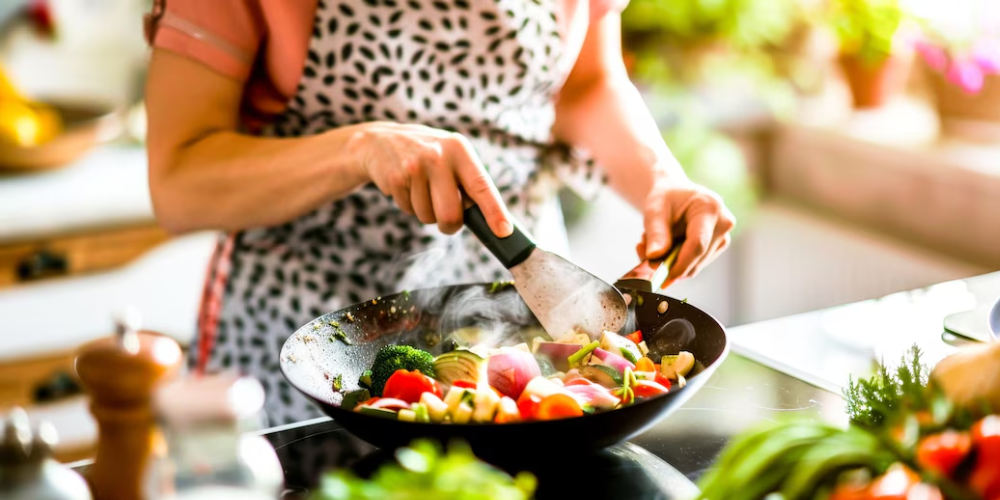
6 Kitchen Tips to Help You Cook with Confidence and Ease

Cooking can feel intimidating, especially when you’re just starting out. Recipes often seem overly simplified, and social media videos make it look like everything can be done perfectly in a few seconds. If you’re not familiar with the art of searing a steak or sautéing vegetables, it can be overwhelming, and your meal may not turn out as expected. But don’t worry—every skilled chef once started in the same place. With practice, patience, and the right approach, you can develop the confidence to cook delicious meals in your own kitchen.
These kitchen tips will help you refine your techniques, improve your skills, and create better dishes at home.
Transform Your Cooking Skills with These Simple Kitchen Tips
1. Find Your Balance in the Kitchen
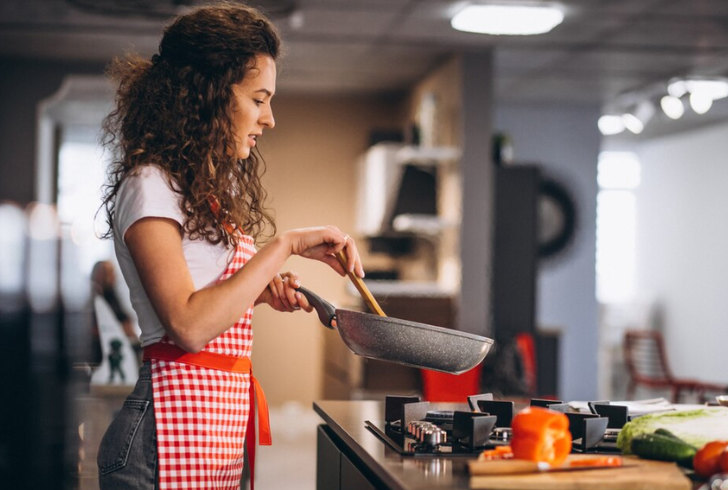
Freepik | senivpetro | Start by adopting the right stance; proper body positioning can greatly enhance your confidence in the kitchen.
The first step to becoming more confident in the kitchen is ensuring you have the right stance. Positioning your body properly can make a significant difference when cooking. Stand with your hips squared to the counter or stove so that you’re fully aligned with your workspace.
This helps with stability and ensures that you’re comfortable while preparing your ingredients. When everything is within reach, you minimize unnecessary movements, reducing the chances of spills, burns, or mishaps.
2. Grasp Control of Your Cooking Tools
Whether it’s a skillet or a spatula, the tools you use are an extension of yourself in the kitchen. Hold onto the handle of the pan firmly with one hand, while your other hand controls the utensils like spatulas, spoons, or tongs. Having a firm grip on these tools allows you to control the cooking process smoothly, ensuring that nothing slips or burns.
3. When and How to Heat a Pan
Understanding heat control is critical. For a stainless-steel pan, always heat it before adding oil. This technique prevents ingredients from sticking to the surface. Once you see faint wisps of smoke, it’s time to add your oil. Then, tilt the pan and observe how the oil behaves. When it moves swiftly in thin ripples, the pan is ready for your ingredients. If you’re using a nonstick pan, add oil and heat it simultaneously.
When frying, be sure to place the food gently into the oil to avoid dangerous splashes. Tongs are excellent for lowering food into hot oil with precision.
4. Perfect the Art of Sautéing
Sautéing might seem complex, but once you grasp the basics, it becomes second nature. Always make sure your ingredients are arranged in a single layer in the pan. If you crowd the pan, the ingredients will steam instead of browning, which prevents that delicious caramelization. Stir or flip your ingredients after a minute or two to ensure even cooking.
5. Know When to Stir and When Not To
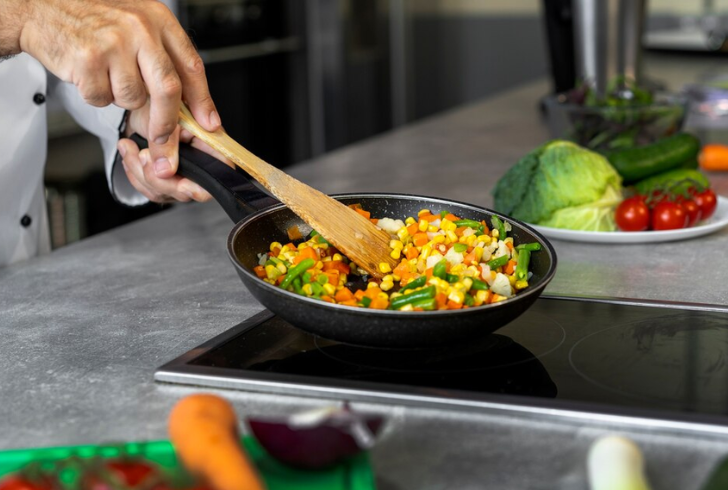
Freepik | Different foods need varying levels of attention; some require frequent stirring, while others should cook undisturbed.
Different foods require different levels of attention. Some ingredients benefit from frequent stirring, while others need to cook undisturbed. For instance, rice needs to absorb moisture without being disturbed, so it’s best left covered. Spaghetti, on the other hand, should be stirred occasionally to keep the strands separate. When searing meat, don’t rush to flip it. Wait until it releases from the pan naturally, indicating that it’s cooked properly on one side.
6. Learn to Manage Smoke and Steam
One of the most common sources of confusion in the kitchen is the difference between smoke and steam. While a little smoke from your pan may not be alarming, it’s a sign that you should reduce the heat to avoid burning. Steam, on the other hand, can be an asset. For example, when making a sauce, leaving the pan uncovered allows steam to escape, thickening the mixture. If a sauce becomes too thick, simply covering the pan can trap the moisture, loosening it up again.
By mastering these kitchen tips, you’ll build a strong foundation for cooking confidently and creatively. With the right tools, techniques, and a little practice, you’ll find yourself more at ease, capable of handling a variety of dishes with finesse. Whether you’re just starting out or looking to improve your culinary skills, these steps will guide you toward more successful and enjoyable cooking experiences.
More in Food
-
`
Simple Steps to Make the Philadelphia Cheesecake Recipe
If you’re looking to make a dessert that never fails to impress, this Philadelphia cheesecake recipe is your go-to. With its...
August 21, 2024 -
`
How Much Does It Cost to Travel in Europe?
Dreaming of strolling along the Seine in Paris, exploring ancient ruins in Rome, or sipping sangria on a Spanish beach? Europe’s...
August 13, 2024 -
`
Mahershala Ali and Amatus-Sami Karim’s Decade-Long Marriage
Who is Mahershala Ali married to? This question often arises when discussing the acclaimed actor. Mahershala Ali, the talented and versatile...
August 5, 2024 -
`
Is It Normal to Be Sore After a Massage? 9 Ways to Relieve Soreness
Is it normal to be sore after a massage? Many people schedule a massage to drift into a state of relaxation...
August 3, 2024 -
`
Delicious Pescatarian Breakfast Ideas
Exploring new breakfast ideas can be a delightful way to start your day, especially when they align with a pescatarian diet....
July 24, 2024 -
`
Is Phuket Worth Visiting in 2024?
Phuket, Thailand’s gem of an island, has long attracted travelers with its pristine beaches, lively nightlife, and cultural treasures. The question...
July 19, 2024 -
`
What is the Best Way to Melt Chocolate for Any Recipe?
Chocolate is a beloved ingredient in many desserts, from ganache and cake batters to decadent drizzles over ice cream. Knowing what...
July 12, 2024 -
`
How to Plan a Backpacking Trip Like a Pro in 16 Steps
Planning a backpacking trip can be as thrilling as it is daunting, especially if you’re keen to make every moment count....
July 5, 2024 -
`
How to Build Fast-Twitch Muscles in 5 Simple Steps
Have you ever wondered how to build fast-twitch muscles? These powerful muscle fibers are key to explosive strength and speed. Whether...
June 20, 2024







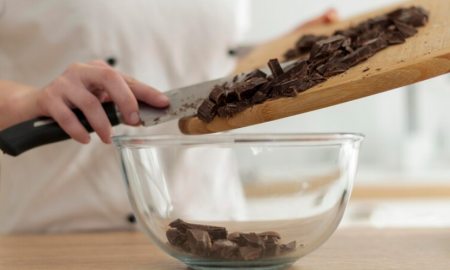



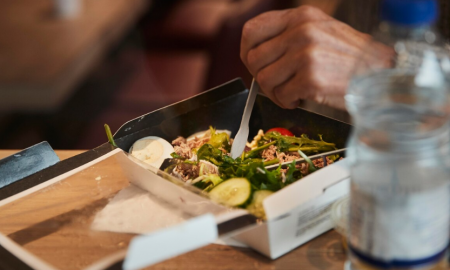



You must be logged in to post a comment Login